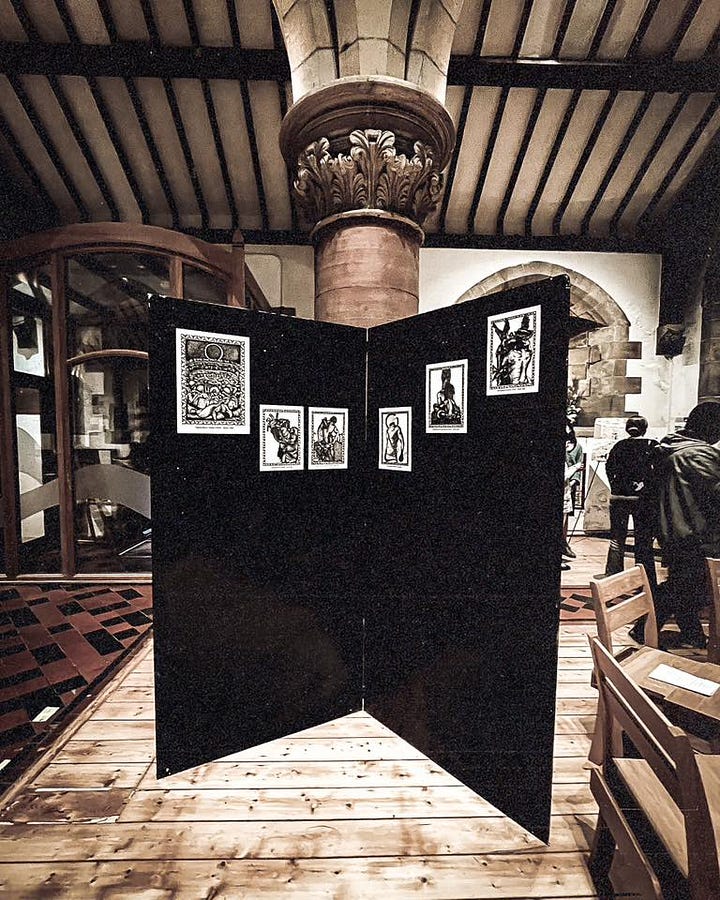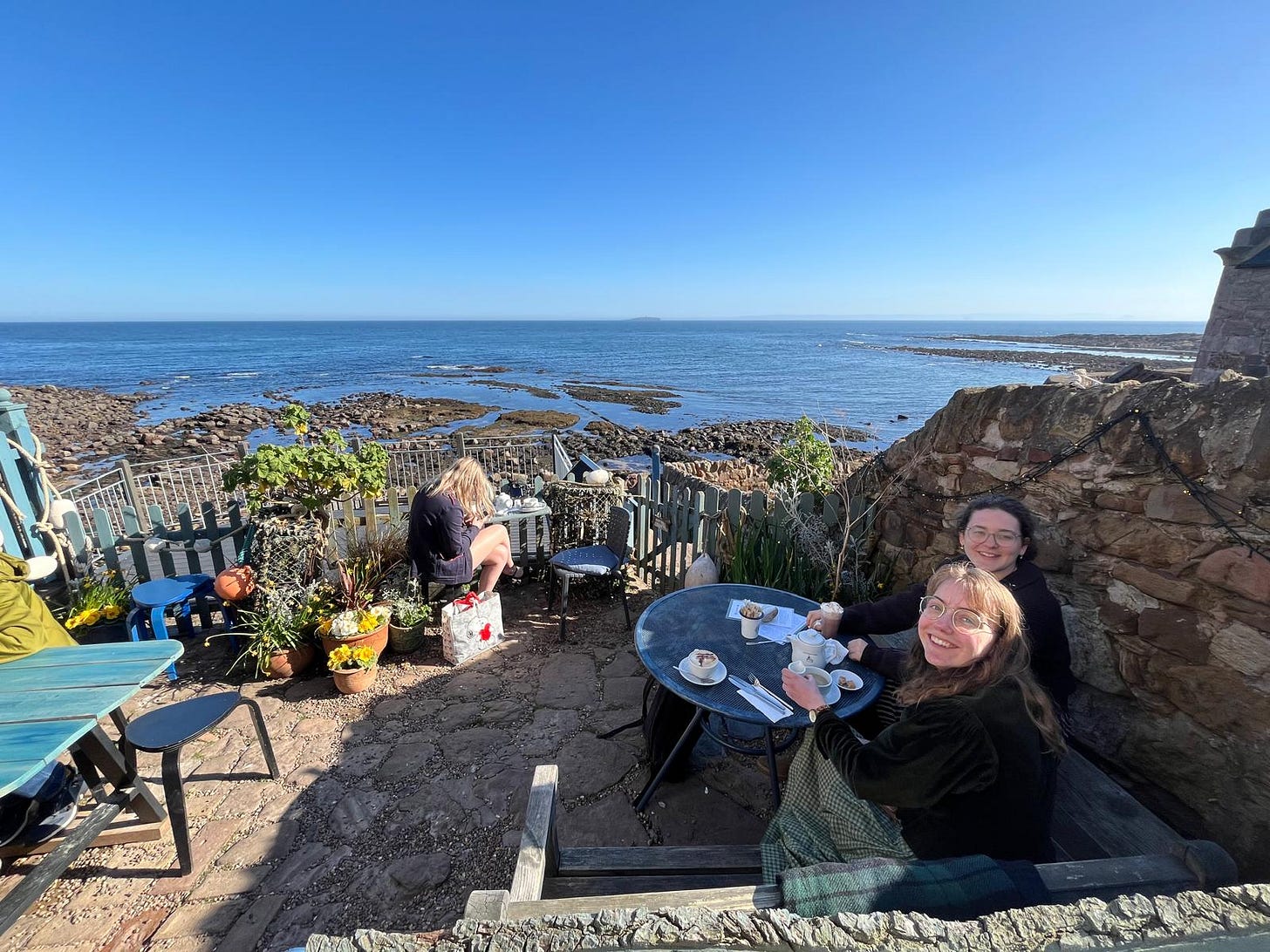Dear friends,
First and foremost, Christ is risen! Recovering from a three-day intensive seminar on Rainer Maria Rilke (imagine reading German poetry for three days straight with a group of Heidegger scholars) just after an art exhibition over the weekend nearly made me forget that the most important days of the Christian year also occurred this past month. So, today, on the thirteenth day of Easter, I wish you a very, very joyous rest of the Easter season. Indeed He is risen!
So yes, Easter. Beyond the feast and endless work on the theology of romantic love paper (more on that in a previous newsletter for Valentine’s Day) this past month was packed with visitors. At the beginning of April, two of my German friends visited for a weekend, which was mainly spent hiking whilst I practised my rusty German. One of my Slovak friends, who came to present his art at the exhibition in St Andrews, left only two days ago.
With both of those visits, I was struck by the way one only becomes truly oneself in relation. Thanks to my friends, I was able to tap into parts of myself usually hidden here in St Andrews. My German friends made me tap into my Germanic side: suddenly, I found myself (slightly) more orderly and on time. My Slovak friend reminded me of my love of Central Europe, where I spent my teens, and more especially, of Eastern Christianity, which I was exposed to in Austria. At the very edges of North-Western Europe, I started singing the Byzantine Easter tunes one usually only hears about a thousand kilometres to the east of us.
Things I’m pondering this month: Artistic Practice
Transept, a group of artists based at the Institute for Theology, Imagination & the Arts where I currently study, organised an exhibition last weekend in St Andrews on the theme of pilgrimages. Most of the artists who exhibited work are travellers who are temporarily in Scotland for work or studies. For them, the theme of journey resonated quite naturally, but even for the more settled artists, the theme of pilgrimage found its way into art about the Christian’s journey to ever closer closeness to God.
The aforementioned Slovak visitor, Samuel Rinik, was one of the travelling contributors to the exhibition. His contribution fitted perfectly to the idea of a journey of growing closeness to God, with his series of drawings depicting man’s growth from vice to virtue (the pictures below show the overall setup in St Andrews: for a better look at the individual drawings, Samuel’s Instagram or Behance is the place to be.)


Since Samuel arrived later on in the weekend, I was tasked with installing his work in the church which served as the exhibition’s gallery. Some of Samuel’s earlier drawings, made in 2020, I’d seen before, but the later ones were new to me. It was brilliant to see how his series of drawings not only depicted man’s growth, but also Samuel’s own growth as an artist. I met Samuel a few years back, and hearing he was an artist, within the first ten minutes of meeting him, I quite enthusiastically mentioned the degree in Theology & the Arts I hoped to pursue. Its fairly providential to welcome him to St Andrews three years later and see how his earlier artistic ambitions have borne fruit.
But the exhibition wasn’t only visual art. It also included an evening of performances, to which I was pleased to contribute a rendition of the Dutch song Vermoeide Reiziger. The song is a Dutch song of encouragement to wayfarers by the folk duo Elly en Rikkert. One of my classmates accompanied on the guitar (thanks once again, friend!)
I translated the original Dutch lyrics into English for this performance, which was quite a fun exercise, especially since Elly & Rikkert themselves are quite well known for translating popular English music into Dutch. The translation is a bit clunky, and of course not half as beautiful as the original Dutch, but I’m happy to share it here nonetheless:
/ Wearied traveller,
Here is a resting place,
Take off your shoes,
And rest for a little while.
With bread and wine
I’ll give you new strength,
I’ll be your hearth,
I will warm you
Everlasting arms will carry you on.
///
Wearied warrior,
Here is a hiding place,
Now bathe your feet
And sleep, sleep till the morning.
With bread and wine
I will give you courage
I’ll be your shield,
I’ll give you compassion,
Everlasting arms will carry you on. /
This, then, is where all our pilgrimages are leading to: a place of hospitality, of rest, of good food and wine, a true home. I’m happy I’ve been able to spend some of my pilgrimaging here in St Andrews.
Recommendations: Sacred Music
Hildegard of Bingen, Ordo Virtutum Scene III, recorded by Sequentia
First, some music from the West. Hildegard of Bingen, one of the Rhineland mystics, is perhaps my favourite saint. A 13th-century abbess, she is known for her mystical visions, her botanical research and last but not least, her musical compositions. It is this last talent of hers I recently discovered. At the Transept exhibition some of my musically talented friends from the Sacred Music programme performed one of Hildegard’s works for us, specifically scene III of the Ordo Virtutum for us. The Ordo Virtutum (Order of the Virtues) is the oldest known allegorical morality play from the Middle Ages and depicts the struggle of the human soul (Anima) between the Virtues and the Devil. You can find the Latin original and the English translation of the Ordo Virtutum here. Scene III specifically depicts the return of the Soul to Queen Humility. The music in itself is beautiful enough, but its worth checking out performances of the play as well, for example this Polish one.
Christ Is Risen, by the St Maximus the Confessor Orthodox Church Choir
And now a bit of Eastern music. A friend of mine in St Andrews runs an Orthodox Choir and they performed a mix of Greek and Slavic chants on Easter Monday. The tune above wasn’t sung then, but I’m pleased to recommend it to you now: an the Appalachian melody for the Easter hymn Christ Is Risen. In my humble opinion, “Christ is risen from the dead, trampling down death by death” is quite beautiful in Greek or Russian chant, but it’s best as an American folk tune. This recording is quite formal, but I would highly recommend singing it with a group of Byzantine seminarians who are so jubilant they’re swinging the chandeliers to really lean into the folky elements.
And we’re wrapping up: it seems I started studying in St Andrews merely a few weeks ago, but yesterday I went to the last class of the year. With classes over, its exam time - best of luck to all of those likewise finishing up the academic year, and once again, a blessed Easter to you all!
Greetings from St Andrews,
Maria




